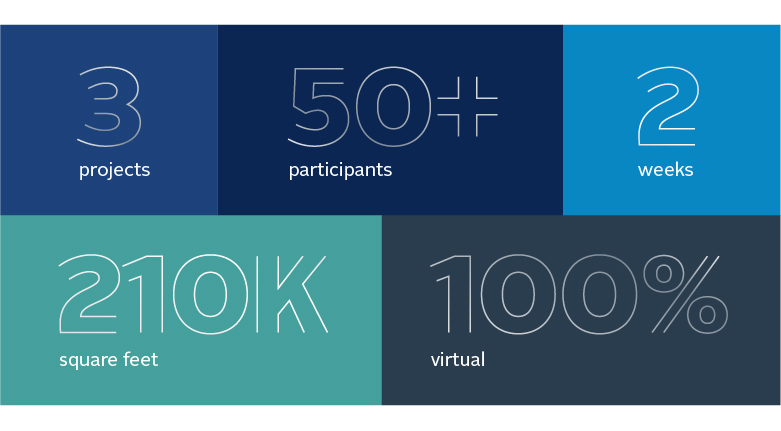Langley F-22 Facilities Charrette Exemplifies the Highest Standards in Virtual Best Practices

Under the best of conditions, design charrettes for our military clients are a grueling challenge. We typically spend five full days locked in a room, with our designers working on concept designs for the proposed project well into the night.
Keep in mind, that’s five full days for one project. So, what happens when you have three projects to design and no way to physically bring 50 or more officials into the same room during a pandemic?
As we discovered in our recent design charrette for three new facilities for F-22 aircraft at Virginia’s Langley Air Force Base, physical presence isn’t necessary to build consensus and move big projects forward. We gathered six times over two weeks, with each project getting a full day and two half-days in the spotlight.
After the two-week period, three new, 70,000-square-foot buildings were charretted. When the 43rd Fighter Squadron, the Formal Training Unit for the F-22 fighter aircraft, relocates from its temporary home at Eglin AFB, Florida to its permanent new home at Langley in 2023, they will have a new hangar to call home, as well as a low observable component repair facility for their stealth technology and a training support squadron facility complete with eight F-22 flight simulators.
With upwards of 70 people tuning into these virtual meetings, we learned a lot of lessons about how design charrettes can remain effective during the COVID-19 pandemic.

It’s the same, just different
The challenges of keeping a large group engaged in such long meetings are similar whether they occur in one room or across a nationwide network.
You have your group of a dozen or so heavily invested attendees. Some people will have to duck out of the meeting unexpectedly. There will be plenty of requests to repeat information.
While we were able to host our meeting via a video conference, more than half of the attendees had to call in via phone. To ensure everyone was on the same page, we made PDFs of our presentations and sent them out to attendees before the meetings. As we presented, we were mindful to point out which page number and sections we were focusing on so that everyone – whether on screen or on the phone – could keep up.

Preparation makes perfect
Leaning on our presentation skills training, we practiced our presentations in advance with the technology that we would be using in the meetings. We worked through a lot of questions and incorporated associates from our Aviation Practice to present and update their BIM models of the facilities.
For a facilitator, the goal for a charrette is to keep everyone organized, to make sure every voice is heard. Maintaining focus is an obvious concern, but we found an audience joining from their homes to be just as engaged.

Release material to the team beforehand
A big part of our success given the technology limits was getting everyone familiar with the project before the meeting took place. We sent out our entire presentation before the meeting so that attendees could be prepared and make additional requests.
Speaking of additional requests, be prepared to receive plenty of them – we had about 20 each day. These requests range from resending documents to technology adjustments, so try to stay flexible to accommodate everyone.
By the same token, record these sessions and keep clear records of everything that is discussed and decided.

Content and delivery must change
With so many people on the phone and online, it can be hard to deliver your points and ensure that everyone hears them. Rather than racing through material and having to go back to make clarifications, cut your material down and slow your delivery. As a result, your message will be more effective.
Your team can help keep the virtual room’s attention by using multiple presenters. Think of your presentation like a newscast, with multiple news anchors taking control of their quick-hitting segments.
We had each of our architects speaking to a few slides apiece and then switch up. We also had the benefit of 3D modeling software that gives our associates the opportunity to walk clients through a project virtually.
By varying speakers and asking a lot of questions, we were able to keep everyone in the meeting engaged. After all, it’s the engagement of the client that helps determine whether a design charrette is successful.
Don’t get lost in the parking lot
Have you ever been in a meeting about one subject and ultimately spend most of the meeting time talking about something else? When you open the floor up for questions and comments, there are plenty you may receive that can take your session down a rabbit hole.
To guard against these tendencies, set up a “parking lot” for issues that are brought up that don’t connect to the project or meeting at hand. This parking lot could be as simple as a running list on paper of these issues.
You can always come back to the parking lot at the end of the meeting to tackle these issues. In fact, your parking lot issues may lead to more productive meetings in the future.
Image credit: U.S. Air Force
Learn more about our defense services.




